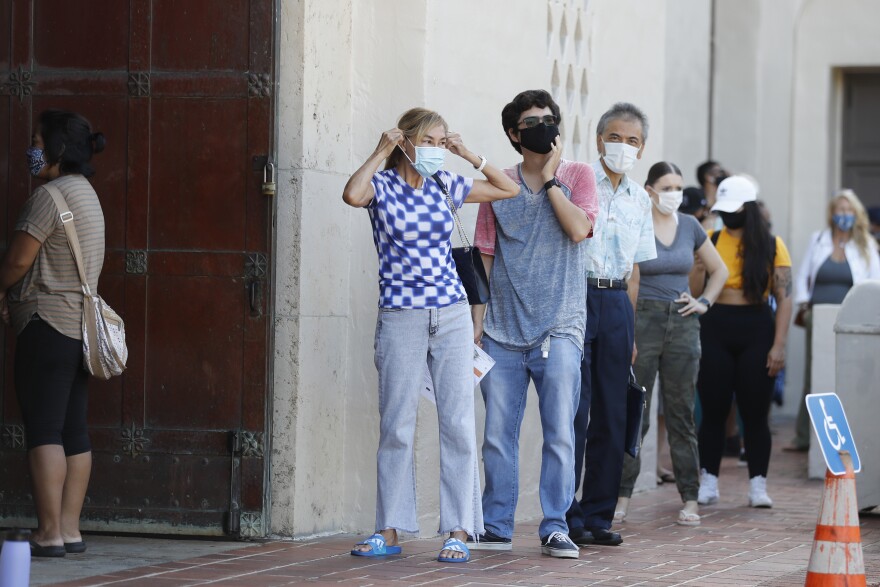Updated: 11/16/2020, 4:58 p.m.
Gov. David Ige today issued a new COVID-19 emergency proclamation—his 15th.
The governor’s office says this one extends and clarifies the statewide mask mandate “as agreed to by all four counties and the state.”
The proclamation says in part: "All persons in the state shall wear a face covering over their nose and mouth when in public.”
The proclamation also says “an owner or operator of any business or operation shall refuse admission or service to any individual who fails to wear a face covering, unless an exception applies.”
The governor’s office says “a face covering mandate has been in place in Hawaii since April 25th.”
Last week, two of Hawaii's top health care leaders called for a statewide mask mandate before the state sees a projected surge in cases over the few weeks.
On Friday, they told the state Senate Special Committee on COVID-9 that data models show another spike is coming, unless the state takes action.
HMSA President Mark Mugiishi says at the top of that action list is a single mask policy.
"There's no question that our priority right now has to be control of the virus via personal behaviors. So personal behaviors are wearing of masks, which, you know, a mask mandate is really something that we can do soon and quickly. And so we should do it," he said. "We should definitely have consistent mask mandates across our state so that people can be educated and wear masks."
Mugiishi said people also need to avoid gatherings. "We know people have some COVID fatigue. We're not going to stop every gathering. So not all gatherings can be treated equally. So if you're going to put five people in a room together to have a meal, do a bento instead of a potluck. Make sure people are wearing masks, you know, when they're not eating, Do it outdoors. You know, there's just ways to make even any kind of gathering safer."
Ige and lawmakers had talked about a mask mandate but their pace had been slow.
House Speaker Scott Saiki had said he doesn't think lawmakers need to convene in a special session and that the governor can take action by executive order; the governor said a mandate is complex and should wait until next year.
But Queen's Health Systems CEO Jill Hoggard Green said the next three to four weeks will make the difference in how the community will fare.
She, too, called for a mask mandate and urged residents to take precautions this fall and winter. She said for Thanksgiving, her family is gathering virtually.
Where we stand
The state Department of Health reported 95 new COVID-19 cases today and no new deaths.
The counts had been released for a time at 3 p.m. but the state returned today to a noontime posting at hawaiicovid19.com (view data dashboard).
Oahu saw 76 new cases, Hawaii County 8, Kauai 2, Maui 7 and Lanai and Molokai 0. Two more out-of-state cases were reported.
As of today, Oahu recorded 14,337 cases, Hawaii County 1,479, Maui 450, Lanai 106, Kauai 82 and Molokai 17. There have been 142 cases diagnosed out of state.
Hawaii likely won't get vaccine for most people until spring
When an approved COVID-19 vaccine is distributed to the states, Hawaii likely won't get enough for everyone at first.
That's one of the challenges the state will face as news spreads that one or more vaccines may be available by the end of the year.
Health care workers, first responders and nursing home residents will be among the first to get the vaccine.
But HMSA President Mark Mugiishi says Hawaii may not even receive enough for those priority groups initially.
"Two big obstacles that I see are obviously one, access to enough vaccines because Hawaii is going to get this much of the allotment across the U.S.," he said. "That's number one, but number two, and maybe the more pressing one is what's going to be public willingness to get the vaccine. And that's something we're all going to have to share responsibility -- in another education kind of initiative."
Another challenge is the Pfizer and Moderna vaccines that have been in the news require two shots about three weeks apart. Mugiishi says the public needs to be willing to return for that second dose.
Top infectious expert Dr. Anthony Fauci says the vaccine will probably be available to most Americans by April.
--HPR's Sandee Oshiro



